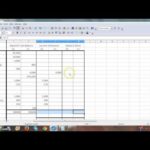16 3 Prepare the Statement of Cash Flows Using the Indirect Method Principles of Accounting, Volume 1: Financial Accounting
The financing activities section shows a total of $16.3 billion was spent on activities related to debt and equity financing. The change in net cash for the period is equal to the sum of cash flows from operating, investing, and financing activities. This value shows the total amount of cash a company gained or lost during the reporting period. A positive net cash flow indicates a company had more cash flowing into it than out of it, while a negative net cash flow indicates it spent more than it earned.
The cash used or provided by operating activities calculated using the indirect method must be the same as that calculated using the direct method. Also, the sections of the cash flow statement where the cash used or provided by investing and financing activities are presented will look exactly the same whether the direct or indirect method is used. Changes in this section of the statement of cash flows come from actions the business takes to finance its operations. Some of the most common and consistent adjustments include depreciation and amortization.
List the net income from the financial statements
Cash flow from operations are calculated using either the direct or indirect method. List out, line by line, the cash your company generated or lost through funding mechanisms such as equity, dividends, and debt. We also allow you to split your payment across 2 separate credit card transactions https://kelleysbookkeeping.com/accounting-equation/ or send a payment link email to another person on your behalf. If splitting your payment into 2 transactions, a minimum payment of $350 is required for the first transaction. List out, line by line, the cash generated or lost through purchasing or selling stocks, securities, or loans.
- To reconcile net income to cash flow from operating activities, subtract increases in current assets.
- Prepare Value Corporation’s statement of cash flows for the year ended June 30, 2018.
- These financial statements are used as internal documents to direct the firm’s operations.
- Once you have calculated the necessary elements, you can begin to build your statement of cash flows.
One you have your starting balance, you need to calculate cash flow from operating activities. This step is crucial because it reveals how much cash a company generated from its operations. The starting cash balance is necessary when leveraging the indirect method of calculating cash flow from operating activities.
The Statement of Cash Flows for Not-For-Profit Entities
Pull your company’s net income from its income statement, and list it on the first line of the cash flow statement. This is also where you add adjustments for finances, like asset depreciation, which you can insert in parentheses. Indirect method starts with the heading net income further proceeded by depreciation and then recording increase and decrease in assets and liabilities. For Propensity Company, beginning with net income of $4,340, and reflecting adjustments of $9,500, delivers a net cash flow from operating activities of $13,840. Investing net cash flow includes cash received and cash paid relating to long-term assets.

After enrolling in a program, you may request a withdrawal with refund (minus a $100 nonrefundable enrollment fee) up until 24 hours after the start of your program. Please review the Program Policies page for more details on refunds and deferrals. If your employer has contracted with HBS Online for participation in a program, or if you elect to enroll in the undergraduate credit option of the Credential of Readiness (CORe) program, note that policies for these options may differ. The applications vary slightly from program to program, but all ask for some personal background information. If you are new to HBS Online, you will be required to set up an account before starting an application for the program of your choice. Are you interested in gaining a toolkit for making smarter financial decisions and the confidence to clearly communicate them to key stakeholders?
3 Prepare the Statement of Cash Flows Using the Indirect Method
The direct cash flow method includes all the inflows and outflows of cash from operating activities. Rather than accrual accounting, it uses cash basis accounting, which recognizes revenues when cash is received and expenses when they’re paid, providing a real-time look at cash inflows and outflows. The direct method then tallies these payments and expenses similarly to the indirect method to determine a business’s net cash flow.
What is the indirect method of cash flow operating activities?
Under the indirect method, cash flow from operating activities is calculated by first taking the net income from a company's income statement. Because a company's income statement is prepared on an accrual basis, revenue is only recognized when it is earned and not when it is received.
Explore Financial Accounting—one of three courses comprising our Credential of Readiness (CORe) program—to discover how you can unlock critical insights into your organization’s performance and potential. All applicants must be at least 18 years of age, proficient in English, and committed to learning and engaging with fellow participants throughout the program. No, all of our programs are 100 percent online, and available to participants regardless of their location. Our platform features short, highly produced videos of HBS faculty and guest business experts, interactive graphs and exercises, cold calls to keep you engaged, and opportunities to contribute to a vibrant online community. Harvard Business School Online’s Business Insights Blog provides the career insights you need to achieve your goals and gain confidence in your business skills. Specifics about each of these three transactions are provided in the following sections.
AccountingTools
Regardless of your position, learning how to create and interpret financial statements can empower you to understand your company’s inner workings and contribute to its future success. Decreases in net cash flow from investing normally occur when long-term assets are purchased using cash. For example, in the Propensity Company example, there was a decrease in cash for the period relating to a simple purchase of new plant assets, in the amount of $40,000.
- Net book value is the asset’s original cost, less any related accumulated depreciation.
- Decreases in net cash flow from investing normally occur when long-term assets are purchased using cash.
- You owned a piece of land that you had planned to someday use to build a sales storefront.
- The net cash flows from operating activities adds this essential facet of information to the analysis, by illuminating whether the company’s operating cash sources were adequate to cover their operating cash uses.
- In both scenarios, the net income reported on the income statement was lower than the actual net cash effect of the transactions.
- An increase in salaries payable therefore reflects the fact that salaries expenses on the income statement are greater than the cash outgo relating to that expense.
The first step in preparing a cash flow statement is determining the starting balance of cash and cash equivalents at the beginning of the reporting period. Assume that you are the chief financial officer of a company that provides accounting services to small businesses. Further assume that there were no investing or financing transactions, and no depreciation expense for 2018. Net cash flow from operating activities is the net income of the company, adjusted to reflect the cash impact of operating activities. Positive net cash flow generally indicates adequate cash flow margins exist to provide continuity or ensure survival of the company. The magnitude of the net cash flow, if large, suggests a comfortable cash flow cushion, while a smaller net cash flow would signify an uneasy comfort cash flow zone.
Module 13: Statement of Cash Flows
These typically include items like accounts receivable, asset sales, or amortization. The remainder of this section demonstrates preparation of the statement of cash flows of the company whose financial statements are shown in Figure 16.2, Figure 16.3, and Figure 16.4. However, the Financial Accounting Standards Board (FASB) prefers companies use the direct method as it offers a clearer picture of cash flows in and out of a business. Prepare The Statement Of Cash Flows Using The Indirect Method However, if the direct method is used, it is still recommended to do a reconciliation of the cash flow statement to the balance sheet. Prepare the company’s statement of cash flows—indirect method—for the year ended December 31, 2018. The sale of company stock for financing can be recorded in this section, along with repurchase of stock, dividend payment, debt repayments (as long as it is for a financing activity).
What are the indirect and direct methods of preparing the statement of cash flows?
The cash flow direct method determines changes in cash receipts and payments, which are reported in the cash flow from the operations section. The indirect method takes the net income generated in a period and adds or subtracts changes in the asset and liability accounts to determine the implied cash flow.
These steps include the preparation of operating, investing, financing, and non-cash transaction schedule. This section is a summation of the changes to the fixed asset account or the current liabilities account, with the exception of accounts payable. It includes purchasing or selling fixed assets, such as a plant or equipment, and issuing or buying back common stock. Since cash flow statements provide insight into different areas a business used or received cash during a specific period, they’re important financial statements when it comes to valuing a company and understanding how it operates.
Business Case Studies
They are also used as reporting documents for the firm’s investors, creditors, members of the board of directors, and government agencies. Investing and financing transactions are critical activities of business, and they often represent significant amounts of company equity, either as sources or uses of cash. Common activities that must be reported as investing activities are purchases of land, equipment, stocks, and bonds, while financing activities normally relate to the company’s funding sources, namely, creditors and investors. These financing activities could include transactions such as borrowing or repaying notes payable, issuing or retiring bonds payable, or issuing stock or reacquiring treasury stock, to name a few instances. Increases in net cash flow from investing usually arise from the sale of long-term assets.
